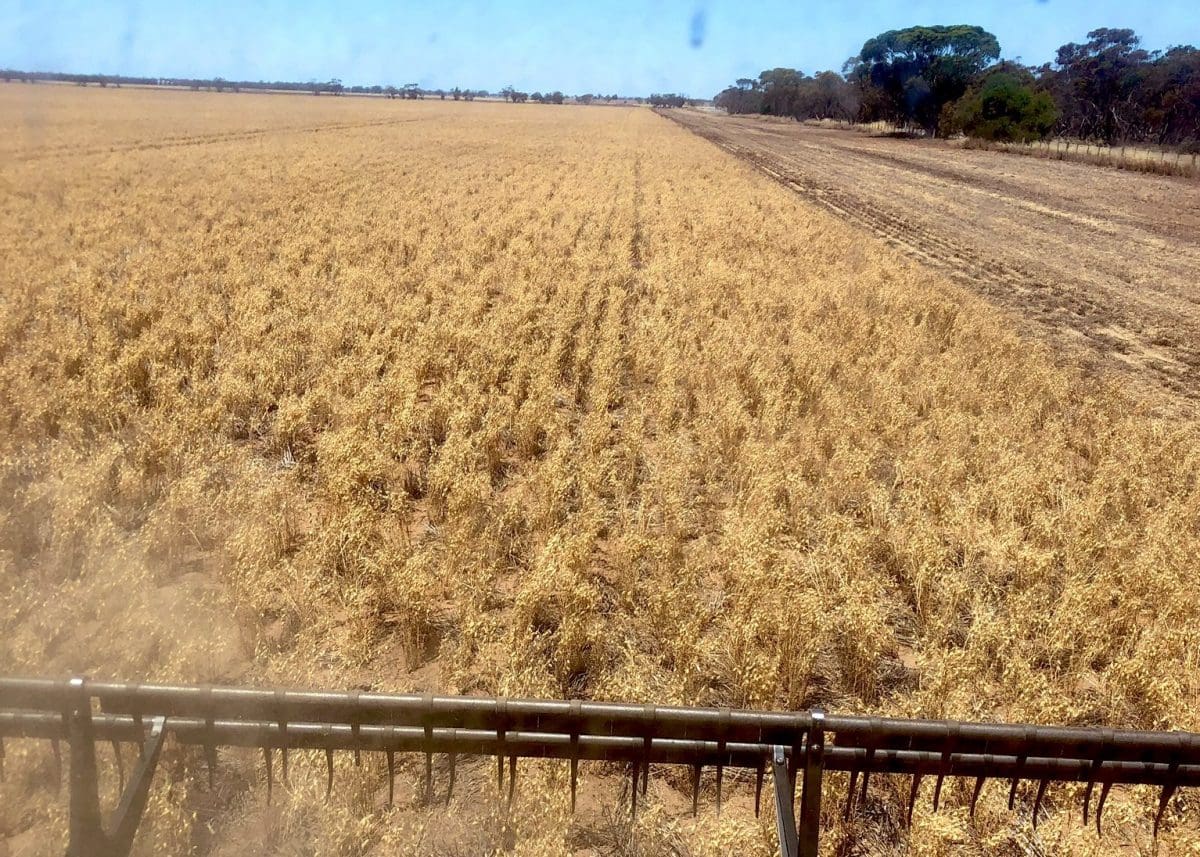
Harvesting chickpeas in the Mallee region earlier this month. Photo: Matt Witney, Dodgshun Medlin
PRICES for chickpeas and lentils are holding steady, while faba bean prices are under considerable supply-side pressure from the biggest crop ever produced in Australia.
Bulk and containerised export programs for all three pulses are now under way as the combined harvest enters its final third and moves into south-west Victoria and south-east South Australia.
The container market is facing some considerable headwinds due to logistics problems tied to the waterside and shipping.
Sources say limited availability on container ships from South-East Asia to South Asia and the Middle East is proving a challenge, and continues to make bulk look like an attractive option.
Chickpeas
Agvantage Commodities principal Steve Dalton said chickpeas were trading at around $600/t delivered Brisbane, or $570/t Darling Downs packer.
This is $20/t or more above mid-November levels, and in part reflects a crop that might not be as big as initially thought.
In its December Australian crop report, ABARES forecast the current chickpea crop at 737,000t, up 4pc from the September estimate.
However, lower-than-expected yields in some NSW-Queensland border areas, and into Queensland, may see a downward revision.
“Chickpeas have been a real see-saw of peaks and troughs.
“February is the latest you can ship out of Australia to get to markets before Ramadan starts in April.
“That’s created some demand.”
Logistics problems for containerised exports are centred in Sydney, where congestion in and around Port Botany is compounding problems for exporters looking for space on ships travelling to South Asia.
“Anywhere from Wee Waa and Narrabri south is having problems with containers; Brisbane is easier.”
Faba beans
Prices for Victorian faba beans are struggling to hold at $300/t delivered Wimmera packer, down around $80/t from mid-November.
The trend of higher-than-expected yields started in NSW last month, and is continuing in SA and Victoria as harvest moves into its final weeks.
Coupled with modest export demand from Australia’s biggest market, as well as the stronger Australian dollar, prices have fallen significantly, but appear to have steadied this week.
“Egypt has adequate supplies from Australia and the Northern Hemisphere,” ETG trader Todd Krahe said.
“I don’t see a great deal of upside in the market until March.
Mr Krahe said domestic feedmillers were pricing an increased amount of faba beans into their rations.
“They’re the cheapest form of protein available.”
ABARES earlier this month forecast the Australian faba bean crop now being harvested at a record 516,000t, up 23pc from its September estimate.
Trade sources say the total has considerable upside, and big yields for all crops are putting pressure on bulk handlers as on-farm storages fill.
“Physical space is an issue.”
Bulk exports of SA faba beans will start early next month with a 15,000t part cargo to Egypt, which follows a comparable tonnage which left Newcastle last month.
“Some bulk helps to take the pressure off the market for sure.”
Peaco general manager Shane Wall said grower selling had slowed considerably now that the up-country bid had sunk to around $300/t.
“Growers aren’t happy with that price, and a lot of fabas are going into warehousing.”
Mr Wall said growers in Victoria were preoccupied with getting harvest finished, and selling had taken a back seat in the past week or two.
“Once growers come off the header, they’ll have another look at where the market is.”
Lentils
Lentils delivered up-country packer have been trading in the $580-$620/t range for most of this month, down at least $50/t on last month’s prices.
The drop reflects the 31 December cut-off date for India’s lowered tariff, after which it will revert to 30 per cent from 10pc.
Harvesting of lentils in the Murray-Mallee is now over, and is moving into the Wimmera and SA’s South-East.
Accumulation for bulk shipments out of Portland in Victoria next month appear to be supporting prices.
“Most growers are sitting on their hands until they get harvest finished,” Wimpak general manager James French said.
Trade sources report that Australian lentils are priced more attractively than Canadian ones, and that Bangladesh is particularly interested in Nipper-type lentils in the lead-up to Ramadan.
“It should be a sell for the grower at around $600,” one trader said.
Mr Krahe said accumulation for bulk exports appeared to be supporting the nearby market, but the big yields were putting pressure on values.
“Yields caught everyone by surprise.”
Some growers have been storing lentils straight off the header and into grain bags on farm to enable them to rip through harvest as quickly as possible to avoid rain events which are passing through south-eastern Australia.
“Come January, we’ll see lentils coming out of grain bags.”
Mungbeans
Mungbeans in southern Queensland and northern NSW are ideally planted in January, and how much area goes in depends very much on the amount of rain growers receive between now and the New Year.
Uncertainty about China’s demand for new-crop mungbeans is limiting forward sales from growers and traders, and prices for the crop which will be harvested in April-May appear to be steady on last month.
No. 1 grade is nominally trading at $1300/t delivered up-country packer, while processing is at $1200/t and manufacturing at $1100.
Most of the small spring crop grown in north Queensland has already been exported, with China the major market.
Grain Central: Get our free cropping news straight to your inbox – Click here

HAVE YOUR SAY